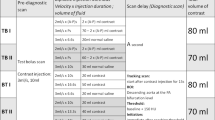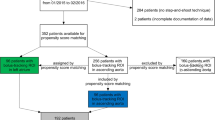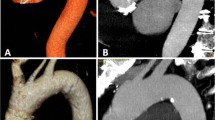Abstract
To investigate the feasibility of aortic computed tomography angiography (CTA) performed at 80 kVp in lean patients using the double region of interest timing bolus (DRTB) technique compared to 100 kVp scanning. This study was approved by the institutional ethics committee, and all patients provided written informed consent. We prospectively included 165 patients from July 2018 to February 2019. We used an 80 kVp protocol when the maximal tube current did not exceed the limit using automatic exposure control; otherwise, 100 kVp was selected. The scan parameters for aortic CTA were determined from the test scan data. Enhancement at six points of the aortoiliac arteries and noise at the bifurcation level were measured. We compared the enhancement and signal to noise ratio (SNR) using Student’s t-test. The tube voltage was 80 kVp in 87 patients (53%). The enhancement of the aortoiliac arteries was significantly higher (449.3 ± 77.8 vs 378.7 ± 53.1 HU, p < 0.0001) and the SNR was similar (42.4 ± 11.1 vs 40.0 ± 10.6, p = 0.17), and the amount of contrast medium was lower (33.0 ± 2.5 vs 41.8 ± 3.3 ml, p < 0.001) in the 80 kVp group compared to the 100 kVp group. Reducing the tube current to 80 kVp could decrease the amount of contrast medium used compared to the 100 kVp protocol, while maintaining image quality, for aortic CTA using the DRTB technique.





Similar content being viewed by others
References
Do C (2017) Intravenous contrast: friend or foe? A review on contrast-induced nephropathy. Adv Chronic Kidney Dis 24:147–149. https://doi.org/10.1053/j.ackd.2017.03.003
Higashigaito K, Schmid T, Puippe G et al (2016) CT angiography of the aorta: prospective evaluation of individualized low-volume contrast media protocols. Radiology 280:960–968. https://doi.org/10.1148/radiol.2016151982
Shuman WP, O’Malley RB, Busey JM et al (2017) Prospective comparison of dual-energy CT aortography using 70% reduced iodine dose versus single-energy CT aortography using standard iodine dose in the same patient. Abdom Radiol 42:759–765. https://doi.org/10.1007/s00261-016-1041-z
Tomizawa N, Ito S, Nakao T et al (2019) Double ROI timing bolus technique to perform aortic CT angiography with a 9-second contrast injection duration. Am J Roentgenol 213:1–8. https://doi.org/10.2214/AJR.18.20766
Tomizawa N, Hayakawa Y, Inoh S, et al (2016) Spiral flow tube for saline flush in coronary CT angiography: initial experience. Int J Radiol 3:90–94. https://doi.org/10.17554/j.issn.2313-3406.2016.03.31
Bae KT (2010) Intravenous contrast medium administration and scan timing at CT: considerations and approaches. Radiology 256:32–61. https://doi.org/10.1148/radiol.10090908
Cohen J (1960) A coefficient of agreement for nominal scales. Educ Psychol Meas 20:37–46
Goenka AH, Herts BR, Dong F et al (2016) Image noise, CNR, and detectability of low-contrast, low-attenuation liver lesions in a phantom: effects of radiation exposure, phantom size, integrated circuit detector, and iterative reconstruction. Radiology 280:475–482. https://doi.org/10.1148/radiol.2016151621
Goenka AH, Herts BR, Obuchowski NA et al (2014) Effect of reduced radiation exposure and iterative reconstruction on detection of low-contrast low-attenuation lesions in an anthropomorphic liver phantom: an 18-reader study. Radiology 272:154–163. https://doi.org/10.1148/radiol.14131928
Kidoh M, Nakaura T, Nakamura S et al (2014) Novel contrast-injection protocol for coronary computed tomographic angiography: contrast-injection protocol customized according to the patient’s time-attenuation response. Heart Vessel 29:149–155. https://doi.org/10.1007/s00380-013-0338-x
Mahnken AH, Rauscher A, Klotz E et al (2007) Quantitative prediction of contrast enhancement from test bolus data in cardiac MSCT. Eur Radiol 17:1310–1319. https://doi.org/10.1007/s00330-006-0486-9
Masuda T, Nakaura T, Funama Y et al (2018) Effect of patient characteristics on vessel enhancement at lower extremity CT angiography. Korean J Radiol 19:265. https://doi.org/10.3348/kjr.2018.19.2.265
Tomizawa N, Komatsu S, Akahane M et al (2012) Influence of hemodynamic parameters on coronary artery attenuation with 320-detector coronary CT angiography. Eur J Radiol 81:230–233. https://doi.org/10.1016/j.ejrad.2010.12.039
Baxa J, Vendiš T, Moláček J et al (2014) Low contrast volume run-off CT angiography with optimized scan time based on double-level test bolus technique: feasibility study. Eur J Radiol 83:147–155. https://doi.org/10.1016/j.ejrad.2013.12.004
Wei L, Li S, Gao Q et al (2016) Use of low tube voltage and low contrast agent concentration yields good image quality for aortic CT angiography. Clin Radiol 71:1313.e5–1313.e10. https://doi.org/10.1016/j.crad.2016.07.018
Annoni AD, Mancini ME, Andreini D et al (2017) Overall evaluability of low dose protocol for computed tomography angiography of thoracic aorta using 80 kV and iterative reconstruction algorithm using different concentration contrast media. J Med Imaging Radiat Oncol 61:614–621. https://doi.org/10.1111/1754-9485.12608
Vasconcelos R, Vrtiska TJ, Foley TA et al (2017) Reducing iodine contrast volume in CT angiography of the abdominal aorta using integrated tube potential selection and weight-based method without compromising image quality. Am J Roentgenol 208:552–563. https://doi.org/10.2214/AJR.16.16613
Seehofnerová A, Kok M, Mihl C et al (2015) Feasibility of low contrast media volume in CT angiography of the aorta. Eur J Radiol Open 2:58–65
Fleischmann U, Pietsch H, Korporaal JG et al (2018) Impact of contrast media concentration on low-kilovolt computed tomography angiography. Invest Radiol 53:264–270. https://doi.org/10.1097/RLI.0000000000000437
Böning G, Rotzinger RA, Kahn JF et al (2018) Tailored CT angiography in follow-up after endovascular aneurysm repair (EVAR): combined dose reduction techniques. Acta Radiol 59:1316–1325. https://doi.org/10.1177/0284185118756952
Liu Y, Liu A, Liu L et al (2016) Feasibility of spectral imaging with low-concentration contrast medium in abdominal CT angiography of obese patients. Int J Clin Pract 70:B37–B43. https://doi.org/10.1111/ijcp.12856
Carrascosa P, Capunay C, Rodriguez-Granillo GA et al (2014) Substantial iodine volume load reduction in CT angiography with dual-energy imaging: insights from a pilot randomized study. Int J Cardiovasc Imaging 30:1613–1620. https://doi.org/10.1007/s10554-014-0501-1
Patel AA, Sutphin PD, Xi Y et al (2019) Arterial phase CTA replacement by a virtual arterial phase reconstruction from a venous phase CTA: preliminary results using detector-based spectral CT. Cardiovasc Intervent Radiol 42:250–259. https://doi.org/10.1007/s00270-018-2096-8
Okayama S, Seno A, Soeda T et al (2012) Optimization of energy level for coronary angiography with dual-energy and dual-source computed tomography. Int J Cardiovasc Imaging 28:901–909. https://doi.org/10.1007/s10554-011-9897-z
Author information
Authors and Affiliations
Corresponding author
Ethics declarations
Conflict of interest
All authors declare no conflict of interest.
Ethical approval
All procedures performed in studies involving human participants were in accordance with the ethical standards of the institutional and/or national research committee and with the 1964 Helsinki declaration and its later amendments or comparable ethical standards.
Informed consent
Informed consent was obtained from all individual participants included in the study.
Additional information
Publisher's Note
Springer Nature remains neutral with regard to jurisdictional claims in published maps and institutional affiliations.
Rights and permissions
About this article
Cite this article
Tomizawa, N., Ito, S., Nakao, T. et al. Aortic CT angiography using the double region of interest timing bolus technique: feasibility of 80 kVp scanning in lean patients. Int J Cardiovasc Imaging 35, 2113–2121 (2019). https://doi.org/10.1007/s10554-019-01660-3
Received:
Accepted:
Published:
Issue Date:
DOI: https://doi.org/10.1007/s10554-019-01660-3




